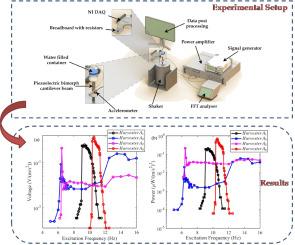流体晃动增广参量激励增强压电振动能量收集
IF 4.9
3区 工程技术
Q2 ENGINEERING, ELECTRICAL & ELECTRONIC
引用次数: 0
摘要
本文研究了一种采用悬臂双晶圆梁与部分充水的圆柱形容器集成的压电振动能量采集器的综合实验研究。该系统受到垂直基础激励,旨在诱导主参数共振,同时利用流体晃动动力学作为提高能量收集性能的手段。目的是研究参数激励和非线性流固耦合对装置能量收集效率和带宽的协同效应。罐内液体的存在导致了动态晃动现象,这种现象具有多种晃动模式,并与梁的横向运动相耦合。通过系统地改变激励频率和液体深度,实验评估了它们对不同电阻性负载下输出电压和电功率的影响。结果表明,主参数激励(基振频率调至接近系统基振频率的两倍)与晃动诱导的模态耦合相结合可以显著提高收集器的带宽。由于增加的惯性和液体迁移率,增加液体深度有效地降低了系统的第一固有频率,从而使参数共振区向更低的频率移动。此外,水深与容器直径的比值作为可调的几何参数,可以控制作业带宽。在不增加系统物理尺寸的情况下,在更高的液体深度下,有效能量收集带宽增加了58%。本文章由计算机程序翻译,如有差异,请以英文原文为准。

Fluid sloshing augmented parametric excitation for enhanced piezoelectric vibration energy harvesting
This study presents a comprehensive experimental investigation of a piezoelectric vibration energy harvester employing a cantilever bimorph beam integrated with a cylindrical container partially filled with water. The system is subjected to vertical base excitation designed to induce principal parametric resonance, while simultaneously exploiting fluid sloshing dynamics as a means of enhancing energy harvesting performance. The objective is to examine the synergistic effects of parametric excitation and nonlinear fluid–structure interaction on the energy harvesting efficiency and bandwidth of the device. The presence of liquid in the tank introduces dynamic sloshing phenomena, characterized by multiple sloshing modes, which couple with the beam’s transverse motion. Through systematic variation of excitation frequency and liquid depth, the experiment evaluates their influence on the voltage output, and electrical power across different resistive loads. Results demonstrate that the combination of principal parametric excitation, where the base excitation frequency is tuned close to twice the system’s fundamental frequency, and sloshing-induced modal coupling can significantly enhance the harvester’s bandwidth. Increasing the liquid depth effectively reduces the system’s first natural frequency due to the added inertia and liquid mobility, thereby shifting the parametric resonance zone toward lower frequencies. Additionally, the water depth-to-container diameter ratio serves as a tunable geometric parameter that allows control over the operational bandwidth. 58% increase in the effective energy harvesting bandwidth is recorded at higher liquid depths, without the need for increasing the system’s physical size.
求助全文
通过发布文献求助,成功后即可免费获取论文全文。
去求助
来源期刊

Sensors and Actuators A-physical
工程技术-工程:电子与电气
CiteScore
8.10
自引率
6.50%
发文量
630
审稿时长
49 days
期刊介绍:
Sensors and Actuators A: Physical brings together multidisciplinary interests in one journal entirely devoted to disseminating information on all aspects of research and development of solid-state devices for transducing physical signals. Sensors and Actuators A: Physical regularly publishes original papers, letters to the Editors and from time to time invited review articles within the following device areas:
• Fundamentals and Physics, such as: classification of effects, physical effects, measurement theory, modelling of sensors, measurement standards, measurement errors, units and constants, time and frequency measurement. Modeling papers should bring new modeling techniques to the field and be supported by experimental results.
• Materials and their Processing, such as: piezoelectric materials, polymers, metal oxides, III-V and II-VI semiconductors, thick and thin films, optical glass fibres, amorphous, polycrystalline and monocrystalline silicon.
• Optoelectronic sensors, such as: photovoltaic diodes, photoconductors, photodiodes, phototransistors, positron-sensitive photodetectors, optoisolators, photodiode arrays, charge-coupled devices, light-emitting diodes, injection lasers and liquid-crystal displays.
• Mechanical sensors, such as: metallic, thin-film and semiconductor strain gauges, diffused silicon pressure sensors, silicon accelerometers, solid-state displacement transducers, piezo junction devices, piezoelectric field-effect transducers (PiFETs), tunnel-diode strain sensors, surface acoustic wave devices, silicon micromechanical switches, solid-state flow meters and electronic flow controllers.
Etc...
 求助内容:
求助内容: 应助结果提醒方式:
应助结果提醒方式:


